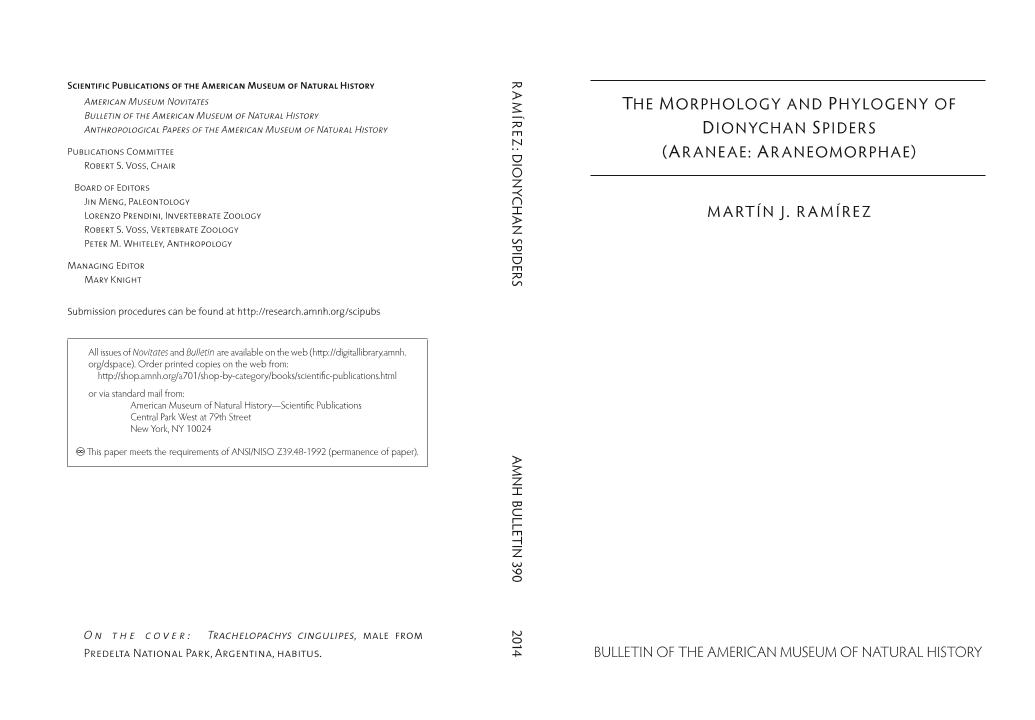Mostrar el registro sencillo del ítem
dc.contributor.author
Ramirez, Martin Javier

dc.date.available
2017-06-12T21:31:34Z
dc.date.issued
2014-06-27
dc.identifier.citation
Ramirez, Martin Javier; The morphology and phylogeny of dionychan spiders (Araneae: Araneomorphae); American Museum Natural History; Bulletin Of The American Museum Of Natural History; 390; 27-6-2014; 1-374
dc.identifier.issn
0003-0090
dc.identifier.uri
http://hdl.handle.net/11336/18066
dc.description.abstract
A phylogenetic analysis of the two-clawed spiders grouped in Dionycha is presented, with 166 representative species of 49 araneomorph families, scored for 393 characters documented through standardized imaging protocols. The study includes 44 outgroup representatives of the main clades of Araneomorphae, and a revision of the main morphological character systems. Novel terminology is proposed for stereotyped structures on the chelicerae, and the main types of setae and silk spigots are reviewed, summarizing their characteristics. Clear homologs of posterior book lungs are described for early instars of Filistatidae, and a novel type of respiratory structure, the epigastric median tracheae, is described for some terminals probably related with Anyphaenidae or Eutichuridae. A new type of crypsis mechanism is described for a clade of thomisids, which in addition to retaining soil particles, grow fungi on their cuticle. Generalized patterns of cheliceral setae and macrosetae are proposed as synapomorphies of the Divided Cribellum and RTA clades. Dionycha is here proposed as a member of the Oval Calamistrum clade among the lycosoid lineages, and Liocranoides, with three claws and claw tufts, is obtained as a plausible sister group of the dionychan lineage. The morphology of the claw tuft and scopula is examined in detail and scored for 14 characters highly informative for relationships. A kind of seta intermediate between tenent and plumose setae (the pseudotenent type) is found in several spider families, more often reconstructed as a derivation from true tenent setae rather than as a phylogenetic intermediate. Corinnidae is retrieved in a restricted sense, including only the subfamilies Corinninae and Castianeirinae, while the "corinnid" genera retaining the median apophysis in the copulatory bulb are not clearly affiliated to any of the established families. Miturgidae is redefined, including Zoridae as a junior synonym. The Eutichuridae is raised to family status, as well as the Trachelidae and Phrurolithidae. New synapomorphies are provided for Sparassidae, Philodromidae, and Trachelidae. Philodromidae is presented as a plausible sister group of Salticidae, and these sister to Thomisidae; an alternative resolution placing thomisids in Lycosoidea is also examined. The Oblique Median Tapetum (OMT) clade is proposed for a large group of families including gnaphosoids, trachelids, liocranids, and phrurolithids, all having the posterior median eye tapeta forming a 90u angle, used for navigation by means of the polarized light in the sky as an optical compass; prodidomines seem to have further enhanced the mechanism by incorporating the posterior lateral eyes to the system. The Teutamus group is recognized for members of the OMT clade that are usually included in Liocranidae, but not closely related to Liocranum or phrurolithids. The Claw Tuft Clasper (CTC) clade is proposed for a group of families within the OMT clade, all having a peculiar mechanism grasping the folded base of the claw tuft setae with a hook on the superior claws. The CTC clade includes Trachelidae, Phrurolithidae, and several gnaphosoids such as Ammoxenidae, Cithaeronidae, Gnaphosidae, and Prodidomidae. A remarkable syndrome involving the expansion of the anterior lateral spinnerets, often sexually dimorphic, is here reported for some Miturgidae and several members of the CTC clade, in addition to the known cases in Clubionidae and ??Liocranidae.?? The following genera are transferred from Miturgidae to Eutichuridae: Calamoneta, Calamopus, Cheiracanthium, Cheiramiona, Ericaella, Eutichurus, Macerio, Radulphius, Strotarchus, Summacanthium, and Tecution; Lessertina is transferred from Corinnidae to Eutichuridae. The following genera are transferred to Miturgidae: Argoctenus, Elassoctenus, Hestimodema, Hoedillus, Israzorides, Odomasta, Simonus, Thasyraea, Tuxoctenus, Voraptus, Xenoctenus, Zora, and Zoroides, from Zoridae; Odo and Paravulsor, from Ctenidae; Pseudoceto from Corinnidae. The following genera are transferred from Corinnidae to Trachelidae: Afroceto, Cetonana, Fuchiba, Fuchibotulus, Meriola, Metatrachelas, Paccius, Paratrachelas, Patelloceto, Planochelas, Poachelas, Spinotrachelas, Thysanina, Trachelas, Trachelopachys, and Utivarachna. The following genera are transferred from Corinnidae to Phrurolithidae: Abdosetae, Drassinella, Liophrurillus, Plynnon, Orthobula, Otacilia, Phonotimpus, Phrurolinillus, Phrurolithus, Phruronellus, Phrurotimpus, Piabuna, and Scotinella. Dorymetaecus is transferred from Clubionidae to Phrurolithidae. Oedignatha and Koppe are transferred from Corinnidae to Liocranidae. Ciniflella is transferred from Amaurobiidae to Tengellidae.
dc.format
application/pdf
dc.language.iso
eng
dc.publisher
American Museum Natural History

dc.rights
info:eu-repo/semantics/openAccess
dc.rights.uri
https://creativecommons.org/licenses/by-nc-sa/2.5/ar/
dc.subject
Phylogeny
dc.subject
Spider
dc.subject
Morphology
dc.subject
Dionycha
dc.subject.classification
Zoología, Ornitología, Entomología, Etología

dc.subject.classification
Ciencias Biológicas

dc.subject.classification
CIENCIAS NATURALES Y EXACTAS

dc.title
The morphology and phylogeny of dionychan spiders (Araneae: Araneomorphae)
dc.type
info:eu-repo/semantics/article
dc.type
info:ar-repo/semantics/artículo
dc.type
info:eu-repo/semantics/publishedVersion
dc.date.updated
2017-06-06T18:45:36Z
dc.journal.volume
390
dc.journal.pagination
1-374
dc.journal.pais
Estados Unidos

dc.journal.ciudad
New York
dc.description.fil
Fil: Ramirez, Martin Javier. Consejo Nacional de Investigaciones Científicas y Técnicas. Oficina de Coordinación Administrativa Parque Centenario. Museo Argentino de Ciencias Naturales "bernardino Rivadavia"; Argentina
dc.journal.title
Bulletin Of The American Museum Of Natural History

dc.relation.alternativeid
info:eu-repo/semantics/altIdentifier/url/http://www.bioone.org/doi/abs/10.1206/821.1
dc.relation.alternativeid
info:eu-repo/semantics/altIdentifier/doi/https://doi.org/10.1206/821.1
Archivos asociados
